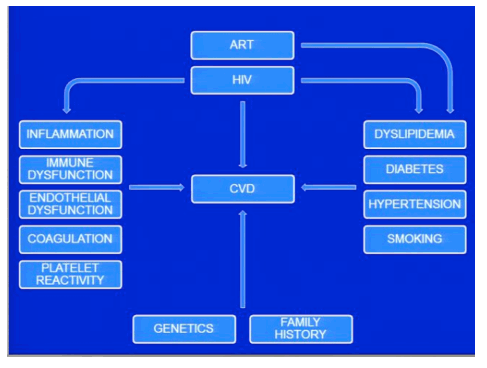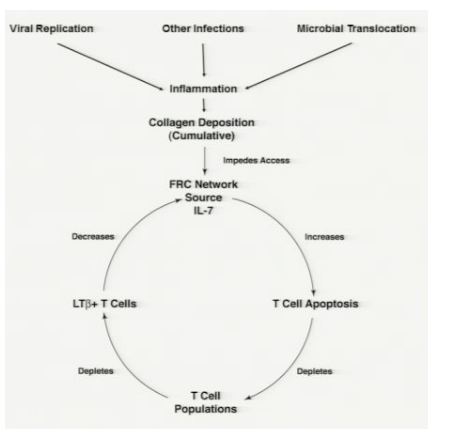 |
 |
 |
| |
Lowest CD4 Count Below 200, by Itself, Raises Heart Disease Risk With HIV: HIV Is a Risk Factor for Heart Disease
|
| |
| |
18th Conference on Retroviruses and Opportunistic Infections, February 27-March 2, 2011, Boston
"They concluded that HIV infection is an independent risk factor of heart disease in this population. A lowest recorded CD4 count under 200 (but not recent CD4 count, recent viral load, antiretroviral use, or HIV risk group) also independently boosted the risk of heart disease in their HIV-positive patients."
[from Jules: CD4 nadir <200 raised risk (RR 12.3); so did 'ever used drugs or alcohol', 'ever smoked tobacco', diabetes, hypertension, on lipid-lowering therapy. I think this study grossly simplifies an attempt to understand CVD risk in HIV by saying in patients with >500 CD4 their risk is no different tha HIV-neg Kaiser patients, as there are so many other considerations & confounders besides CD4 count not considered in this study including at the very least inflammation, activation, viral load and on. In fact in the themed discussion
"Themed Discussion: Atherosclerosis and HIV: Risk Factors and Pathogenesis
3/2/2011 1:00 PM" on wed the last day of the meeting when describing the results of his study Klein said a patient with a CD4 >500 had 'less risk' rather than saying the same risk as HIV-negs which although I could be overinterpreting the statement says he is unsure of his finding that a CD4 >500 equals the same risk in HIV-negs, LINK:
http://app2.capitalreach.com/esp1204/servlet/tc?c=10164&cn=retro&s=20445&&dp=player.jsp&e=13746&mediaType=podiumVideo
in this session Virginia Triant says these factors could in theory explain the path of CVD in HIV: HIV, direct effects of HIV on --inflammation, immune dysfunction, endothelial dysfunction, coagulation, platelet reactivity, dyslipidemia, diabetes, hypertension, treatment interruption-- smoking of course, genetics, family history (and she didn't mention it in this slide but lifestyle too, alcohol drug abuse, poor diet/exercise etc). Triant also referred to the Kaplan study last year at CROI where they found that activated & immunosenescent T cells were associated with an increased prevalence of caroitid lesions even in virologically suppressed patients. SO as you can see the story is much more complicated than having a cd4 >500 being protective.

AND in this important session on Monday "Symposium: HAART at 15
2/28/2011 4:00 PM" in his lecture on Inflammation, Tim Schacker talks about inflammation & activation & how these lead to comorbidities. He said damage to the gut by HIV is irreparable unless perhaps if HAART is started immediately during acute infection as suggested by a few studies including that by Jain et al at this conferennce where they compared starting HAART within 6 months after HIV-infection vs 2 years later and found activation can be significantly reduced if HAART is started early but irreparable if started later.
CROI: Antiretroviral Therapy Initiation during Acute/Early HIV Infection vs. Later ART Initiation is Associated with Improved Immunologic and Virologic Parameters during Suppressive ART - (03/5/11)
Shacker also refers to "accelerated aging" and how the damaged gut damages the immune system forever and how these events cascade to early onset of comorbidities. LINK to his talk:
http://app2.capitalreach.com/esp1204/servlet/tc?c=10164&cn=retro&s=20445&&dp=player.jsp&e=13721&mediaType=podiumVideo


------------------------
Kaiser Study report continues--
Mark Mascolini
A lowest recorded CD4 count below 200 independently raised the risk of coronary heart disease (CHD) and myocardial infarction (MI) in HIV-positive members of California's Kaiser Permanente healthcare system. Heart disease risk did not differ between HIV-negative Kaiser patients and HIV-positive people with either a recent CD4 count above 500 or a lowest CD4 count above 500. Antiretroviral therapy did not boost the heart disease risk in this analysis.
To further define the impact of immunodeficiency, viral load, and antiretroviral therapy on heart disease risk, Kaiser Permanente researchers compared 20,775 HIV-positive people in this healthcare system with 215,158 HIV-negative Kaiser members matched to the HIV group by age, gender, year (from 1996 to 2008), and medical center. Follow-up continued until a person had CHD or MI, until they left the Kaiser system, until death, or until the end of 2008. The Kaiser team divided the HIV group into 6-month intervals, noting the CD4 count and viral load at the start of each interval.
Age averaged 41 in the HIV-positive group and 40 in the HIV-negative group. Among people with HIV, 55% were white, 22% Hispanic, 19% black, and 5% Asian or another or unknown ethnicity. Racial and ethnic proportions were similar in the non-HIV group. A higher proportion of people with HIV ever smoked (43% versus 28%), and a higher proportion ever abused alcohol or drugs (20% versus 8%), but similar proportions were overweight (38% versus 42%). Similar proportions were taking antihypertensives (13% with HIV and 11% without HIV) and lipid-lowering drugs (5% and 4%).
Almost half of those with HIV (47%) were taking antiretrovirals. Gay sex was the most prevalent HIV acquisition risk, in 75%. And years of known HIV infection averaged 3.5. Overall CD4 count and viral load averaged 400 CD4 cells and 50,000 copies/mL.
CHD and MI diagnosis rates were higher in people with HIV than in people without HIV. CHD incidence measured 447 per 100,000 person-years with HIV versus 311 per 100,000 person-years without HIV. Respective rates for MI were 276 and 162 per 100,000 person-years. The Kaiser team devised a multivariate model that considered antiretroviral use, recent and lowest CD4 count above or below 200, viral load above or below 500, HIV transmission risk, age, gender, race, alcohol or tobacco use, overweight or obesity, diabetes, antihypertensive therapy, and lipid-lowering therapy. Nine factors independently raised the risk of CHD or MI at the noted rate ratios (RR) (and 95% confidence intervals):
-- Lowest CD4 below versus above 200: RR 1.3 (1.0 to 1.6), P = 0.022
-- Age 65 or older versus 18 to 39: RR 12.3 (7.2 to 20.8), P < 0.001
-- Age 50 to 64 versus 18 to 39: RR 6.4 (4.0 to 10.4), P < 0.001
-- Age 40 to 49 versus 18 to 39: RR 2.7 (1.7 to 4.4), P < 0.001
-- Ever used tobacco: RR 1.9 (1.5 to 2.4), P < 0.001
-- Ever abused alcohol or drugs: RR 1.3 (1.0 to 1.6), P = 0.036
-- Diabetes: RR 1.5 (1.2 to 2.0), P = 0.001
-- Antihypertensive therapy: RR 1.9 (1.5 to 2.3), P < 0.001
-- Lipid-lowering therapy: RR 1.9 (1.5 to 2.4), P < 0.001
Three factors independently lowered the risk of CHD or MI:
-- Female gender: RR 0.4 (0.2 to 0.8), P = 0.004
-- Black versus white: RR 0.7 (0.5 to 0.9), P = 0.021
-- Hispanic versus white: RR 0.7 (0.5 to 1.0), P = 0.046
Antiretroviral use, recent viral load above to below 500 copies, and HIV transmission risk did not affect CHD or MI rates in this analysis.
The Kaiser team noted that measurement of some risk factors was incomplete and that family history of heart disease was not considered.
They concluded that HIV infection is an independent risk factor of heart disease in this population. A lowest recorded CD4 count under 200 (but not recent CD4 count, recent viral load, antiretroviral use, or HIV risk group) also independently boosted the risk of heart disease in their HIV-positive patients.
The Kaiser researchers argued that their findings "support earlier initiation of antiretroviral therapy and aggressive risk factor management" to prevent CHD and MI.
Reference
1. Klein D, Leyden W, Xu L, et al. Contribution of immunodeficiency to CHD: cohort study of HIV+ and HIV- Kaiser Permanente members. 18th Conference on Retroviruses and Opportunistic Infections. February 27-March 2, 2011. Boston. Abstract 810.
|
| |
|
 |
 |
|
|